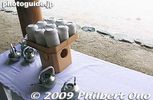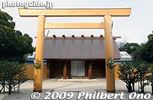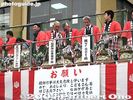 Last additions - AICHI 愛知県 Last additions - AICHI 愛知県 |

JR Kiyosu Station on the JR Tokaido Line between Nagoya and Gifu.Jan 19, 2009
|
|

JR Kiyosu Station platform. Note that only the local (kaku-eki) trains stop at Kiyosu Station. The kaisoku express trains don't stop at Kiyosu.Jan 19, 2009
|
|

Inside JR Kiyosu StationJan 19, 2009
|
|

My bowl of matcha green tea. After we consumed the tea, we just left. The shrines also has many other buildings, but it was too crowded for me to see them all this day. I was too tired walk around more.Jan 18, 2009
|
|

There was no ceremony. We just sat and were served tea and sweet.Jan 18, 2009
|
|

The shrine maidens came around to serve the tea and sweet.Jan 18, 2009
|
|

A sweet confection to eat with the matcha tea.Jan 18, 2009
|
|

The stage was appropriate for New Year's.Jan 18, 2009
|
|

This is the Bunkaden Culture Hall which is behind and attached to the Treasure Hall. This is where they held the tea session.Jan 18, 2009
|
|

Inside the Bunkaden Culture Hall for tea.Jan 18, 2009
|
|

Behind and attached to the Homotsukan Treasure Hall is the Bunkaden Culture Hall where they held a tea session. People form a long line as they wait to enter the Bunkaden. The tea was included in the 1,000 yen I paid to see the inner shrine.Jan 18, 2009
|
|

Follow the sign to exit or to see other shrine buildings.Jan 18, 2009
|
|

Homotsukan Treasure Hall houses and exhibits the shrine's valuable artifacts, including Important Cultural Properties and a National Treasure (a dagger). Many people donated stuff to the shrine, especially swords. 宝物館Jan 18, 2009
|
|

Remnant of the Nobunaga-bei, a roofed mud wall donated to the shrine in 1560 by Oda Nobunaga in gratitude for his victory at the Battle of Okehazama.Jan 18, 2009
|
|

Built in 1686 by Shogun Tsunayoshi, this is Nishi-gakusho, one of the few shrine buildings remaining from before the Meiji Period. Dances and other ceremonies are held here. 西楽所Jan 18, 2009
|
|

Omikuji fortune paper.Jan 18, 2009
|
|

Jan 18, 2009
|
|

Description of various amulets in English.Jan 18, 2009
|
|

Jan 18, 2009
|
|

Jan 18, 2009
|
|

Jan 18, 2009
|
|

Jan 18, 2009
|
|

They also give you a small dish and sake served by a shrine maiden as you exit.Jan 18, 2009
|
|

Shrine amulets were selling like crazy.Jan 18, 2009
|
|

Shrines are in the business of selling good fortune and hope.Jan 18, 2009
|
|

Votive tablets and other trinkets.Jan 18, 2009
|
|

I wonder how much money these wallets contain.Jan 18, 2009
|
|

View of the money pit as seen from the shrine. This is still quite small compared to Meiji Shrine in Tokyo on New Year's Day. Less crowded too.Jan 18, 2009
|
|

Jan 18, 2009
|
|

The shrine's bank will love to count all this money. It must be their favorite time of year.Jan 18, 2009
|
|

Atsuta Jingu Shrine's Hongu main shrine. For 1,000 yen, they let you in here to pray. The architecture and layout are almost the same as the Ise Grand Shrines in Mie Pref. Rebuilt in 1955. I wonder if the sacred sword is in there.Jan 18, 2009
|
|

Jan 18, 2009
|
|

Jan 18, 2009
|
|

New Year's prayers at Atsuta Jingu Shrine on Jan. 1.Jan 18, 2009
|
|

Jan 18, 2009
|
|

Now we stand in line to pray before the shrine.Jan 18, 2009
|
|

Getting closer.Jan 18, 2009
|
|

Coins, bills, gift certificates, and even wallets were thrown in here.Jan 18, 2009
|
|

The police were holding back the crowd at regular intervals before they could enter the shrine's worship area.Jan 18, 2009
|
|

This is what we wanted to see. The offertory pit where people throw their money in front of the Hongu main shrine. 本宮Jan 18, 2009
|
|

Standing in line to pray.Jan 18, 2009
|
|

Jan 18, 2009
|
|

Approaching the final torii.Jan 18, 2009
|
|

Finally, the shrine is in sight.Jan 18, 2009
|
|

We want to go straight.Jan 18, 2009
|
|

We stand still.Jan 18, 2009
|
|

Barrels of sake.Jan 18, 2009
|
|

From the ladle, pour the water into your hand and sip the water to purify yourself before visiting the shrine. This was a most crowded place.Jan 18, 2009
|
|

We got to the wash fountain to purify ourselves.Jan 18, 2009
|
|

Atsuta Shrine was established about 1900 years ago. In the centuries past, the shrine has been patronized by major historical figures such as Oda Nobunaga, Toyotomi Hideyoshi, and the Tokugawa shoguns (Ieyasu was originally from this area).Jan 18, 2009
|
|

The East torii gate of Atsuta Jingu Shrine, made of wood. Atsuta Jingu worships Atsuta-no-Ookami or Amaterasu-Omikami, the Sun Goddess represented by Kusanagi-no-tsurugi, the sacred sword.Jan 18, 2009
|
|

The crowd thickens and it was stop and go, repeatedly.Jan 18, 2009
|
|

Wash fountainJan 18, 2009
|
|

One normal gate was closed and we all had to enter through the East Gate.Jan 18, 2009
|
|

Banner read "Happy New Year."Jan 18, 2009
|
|

This is where the crowd begins on New Year's Day. The shrine also worships four other deities: Susanoo-no-mikoto, Yamato-Takeru-no-Mikoto, and Takeinadane-no-Mikoto and Miyasuhime-no-Mikoto, the parents of the Owari natives (Nagoya area).Jan 18, 2009
|
|

Another train station near Atsuta Shrine is Meitetsu Jingumae Station (this is closer than Atsuta Station). 名鉄神宮前駅Jan 18, 2009
|
|

The road in front of Meitetsu Jingumae Station was closed to traffic, allowing pedestrians to get to Atsuta Shrine on New Year's Day.Jan 18, 2009
|
|

Many food stalls line the way to the shrine on New Year's Day.Jan 18, 2009
|
|

We soon hit a bottleneck where we had to wait a while as we slowly got nearer to the shrine.Jan 18, 2009
|
|

Atsuta Jingu is one of Japan's most important shrines as it enshrines one of the three Imperial Regalia of Japan, the sacred (and perhaps legendary) sword called Kusanagi-no-Tsurugi ("Grass Cutting Sword"). 草薙の剣Jan 18, 2009
|
|

I always visit a different shrine on New Year's Day, so for 2009, I visited Atsuta Jingu Shrine in Nagoya. JR Atsuta Station on the Tokaido Line is one train station near Atsuta Jingu Shrine. JR熱田駅Jan 18, 2009
|
|

Shopping arcade on the way to the shrine from Atsuta Station.Atsuta Jingu is near Meitetsu Jingumae Station, JR Atsuta Station on the Tokaido Line, Atsuta Jingu Nishi Station (renamed from Jingu Nishi Station on Jan. 4, 2023) on the Meijo subway line, and Atsuta Jingu Tenma-cho Station (renamed from Tenma-choStation on Jan. 4, 2023) on the Meijo subway line.Jan 18, 2009
|
|

Worst-looking phallic rock. That's stretching the imagination a little too much.Mar 20, 2007
|
|

Votice tablet with illustration of the Honen Festival.Mar 20, 2007
|
|
|

Phallic souvenirs.Mar 20, 2007
|
|

Mar 20, 2007
|
|

Another pair of trees bonded together.Mar 20, 2007
|
|

And another...Mar 20, 2007
|
|

Mar 20, 2007
|
|

Behind the rocks are two trees bonded together.Mar 20, 2007
|
|

Best-looking phallic rock.Mar 20, 2007
|
|

Female and male rocks.Mar 20, 2007
|
|

Mar 20, 2007
|
|

Phallic rock. There are several phallic rocks donated by various people. Apparently they are either natural or carved.Mar 20, 2007
|
|

Put in money and it will make a "chin" sound. (From the word "chinpo" for penis.)Mar 20, 2007
|
|

Rub the two balls.Mar 20, 2007
|
|

Mar 20, 2007
|
|

Phallic fence posts.Mar 20, 2007
|
|

Place to rub the sacred balls. 珍宝窟Mar 20, 2007
|
|

Votice tablets written with people's wishes for love, sex, and babies.Mar 20, 2007
|
|

Mar 20, 2007
|
|

Mar 20, 2007
|
|

Phallic objectsMar 20, 2007
|
|

Apparently it can become erect too. (Compare with previous photo.)Mar 20, 2007
|
|

Mar 20, 2007
|
|

Note that the phallus is not the object of worship. It is an offering to the god.Mar 20, 2007
|
|

Oku-no-miya Shrine. Look carefully and you can see what's inside. 奥宮Mar 20, 2007
|
|

Oku-no-miya Shrine also has many other phallic objects presented as offerings. There even one which you can touch...Mar 20, 2007
|
|

This is what you see inside Oku-no-miya Shrine. A giant wooden phallus offering.Mar 20, 2007
|
|

Stones and Oku-no-miya ShrineMar 20, 2007
|
|

Torii to Oku-no-miya Shrine, next to the Honden main hall.Mar 20, 2007
|
|

Tagata Shrine Honden main hall. Komaki, Aichi Pref.Mar 20, 2007
|
|

Tagata Shrine Honden main hall which worships shrine worships a deity called Tamahime-no-Mikoto who was a daughter of a powerful local lord from the 5th century.Mar 20, 2007
|
|

Mikuji paper fortunes for love and romance, marriage, and childbirth.Mar 20, 2007
|
|

Tagata Jinja-mae Station on Meitetsu Railways' Komaki Line, a few stops from Inuyama Station. The shrine is a 10 min. walk from the train station.Mar 20, 2007
|
|

Tagata Shrine stone markerMar 20, 2007
|
|

Tagata Shrine torii and entrance 田縣神社Mar 20, 2007
|
|
|

LollipopsMar 17, 2007
|
|

Mar 17, 2007
|
|

The bottom of the woman figurine. Naughty, naughty...Mar 17, 2007
|
|

Sake flaskMar 17, 2007
|
|

Senbei crackersMar 17, 2007
|
|

Mar 17, 2007
|
|

Demure-looking woman figurine looks deceiving until you look at the bottom...Mar 17, 2007
|
|

Mar 17, 2007
|
|

At 4 pm, the festival's final event is the mochi-nage or rice-cake tossing. First, they warn eveyone that the shrine won't be liable for any injury you might incur from this. And the elderly and children should avoid this mochi-nage.Mar 17, 2007
|
|

A large crowd tries to catch numerous mochi which are hard and can be dangerous if it hits you on the face or head. To avoid injury, do not look down and don't try to pick up mochi on the ground. You can get trampled, and most injuries occur this way.Mar 17, 2007
|
|

Mar 17, 2007
|
|

The usual penis souvenirs on sale.Mar 17, 2007
|
|

Mar 17, 2007
|
|

Installed inside the shrine's Honden main hall, the new giant penis will replace the old one.Mar 17, 2007
|
|

Ema votive tablet with giant penis portable shrine. 500 yen.Mar 17, 2007
|
|

Pregnant women also attend the festival. As well as mothers with a young baby coming to give thanks.Mar 17, 2007
|
|

Now comes the giant phallus heading for the shrine's main hall.Mar 17, 2007
|
|
|

Mar 17, 2007
|
|

Carried by men singing kiyari laborers' songs, the smaller wooden phallus also goes to enter the shrine's main hall.Mar 17, 2007
|
|

Portable shrine for Takeinadane-no-MikotoMar 17, 2007
|
|

Tagata Jinja banners.Mar 17, 2007
|
|

Mar 17, 2007
|
|

Mar 17, 2007
|
|

Tagata Shrine grounds during the Honen Festival.Mar 17, 2007
|
|

Giant phallus makes its way to the shrine.Mar 17, 2007
|
|

The giant phallus in front Tagata Shrine's Honden main hall.Mar 17, 2007
|
|

Palanquin for Deity of HarvestsMar 17, 2007
|
|

Penetration successful. This is 3:30 pm.Mar 17, 2007
|
|

The giant penis also arrives at the shrine as it spins around behind theMar 17, 2007
|
|

The phallus is a symbol for themes of fertility.Mar 17, 2007
|
|

Women spectators touch the penis for good fortune and to become fertile perhaps?Mar 17, 2007
|
|

Portable shrine for Takeinadane-no-Mikoto enters the Honden main hall.Mar 17, 2007
|
|

The standard-bearer with a banner of shunga-style penis painting.Mar 17, 2007
|
|

Sarutahiko-no-OkamiMar 17, 2007
|
|

Mar 17, 2007
|
|

Salt sprinkler enters first.Mar 17, 2007
|
|

Tagata Shrine crowded with people waiting for the procession to arrive.Mar 17, 2007
|
|

Entrance to Tagata Shrine crowded with people waiting for the procession to arrive.Mar 17, 2007
|
|

Mar 17, 2007
|
|

Banner of shunga-style penis painting.Mar 17, 2007
|
|

By this time, all the men are filled with sake and gregarious.Mar 17, 2007
|
|

On the main road.Mar 17, 2007
|
|

Mar 17, 2007
|
|

Finally on the main road to Tagata Shrine. Half the road is blocked off for the procession.Mar 17, 2007
|
|

Mar 17, 2007
|
|

Tagata Shrine crowded with people waiting for the procession to arrive.Mar 17, 2007
|
|

DrumMar 17, 2007
|
|

Mar 17, 2007
|
|

Not sure what this is.Mar 17, 2007
|
|

Sarutahiko-no-Okami, the deity who led the descent of Amaterasu (Sun Goddess) from heaven to earth.Mar 17, 2007
|
|
|

Takeinadane-no-MikotoMar 17, 2007
|
|

Mar 17, 2007
|
|

The first half of the route is quite narrow.Mar 17, 2007
|
|

Salt sprinkler heads the procession to purify the way.Mar 17, 2007
|
|

Portable shrine for Takeinadane-no-MikotoMar 17, 2007
|
|

The route is short, but it's a slow procession with many short breaks. The procession lasts 1.5 hours.Mar 17, 2007
|
|

Also see the video at YouTube. Honen-sai Festival, Tagata Shrine Honen Festival.Mar 17, 2007
|
|

Mar 17, 2007
|
|

Branches of the sacred sakaki tree.Mar 17, 2007
|
|

Maidens who are 36 years old, carry wooden penises for protection during their "unlucky age" (yakudoshi).Mar 17, 2007
|
|

Sake cartMar 17, 2007
|
|

Mar 17, 2007
|
|

Toshi-gami deity of harvests.Mar 17, 2007
|
|

Where the penis goes, the crowd follows.Mar 17, 2007
|
|

Mar 17, 2007
|
|

Toshi-gami deity of harvests is pulled on a palanquin instead of being carried.Mar 17, 2007
|
|

The giant phallus by itself weighs about 280 kg (620 lbs.). The total weight of both the phallus and portable shrine housing is 400 kg (885 lbs.).Mar 17, 2007
|
|

Next is a palanquin (not mikoshi) for the Toshi-gami deity of harvests. 御歳神Mar 17, 2007
|
|

They spin around the phallus.Mar 17, 2007
|
|

The second mikoshi features the giant penis carried by 12 men at a time, all of whom are age 42, considered to be an unlucky age (yakudoshi) for men. They seek protection by carrying the phallus.Mar 17, 2007
|
|

Takeinadane-no-MikotoMar 17, 2007
|
|

The procession goers down the slope in front of Kumano Shrine.Mar 17, 2007
|
|

Sarutahiko-no-Okami, the deity who led the descent of Amaterasu (Sun Goddess) from heaven to earth.Mar 17, 2007
|
|

Mar 17, 2007
|
|

People waiting for the procession in front of Kumano Shrine.Mar 17, 2007
|
|

Men in happi coats which read "Honen Matsuri." Honen literally means "year of abundant harvest."Mar 17, 2007
|
|

The giant phallus is called "O-owasegata." It is an offering, and not a deity nor object of worship. Tagata Shrine Honen Festival. A total of 60 men take turns carrying the giant phallus portable shrine. 大男茎形Mar 17, 2007
|
|

People waiting for the procession in front of Kumano Shrine.Mar 17, 2007
|
|

Breaking the sake barrelMar 17, 2007
|
|

The first mikoshi is for Takeinadane-no-Mikoto coming to visit his wife of Tamahime at Tagata Shrine, where Tamahime's residence was located.Mar 17, 2007
|
|

People waiting for the procession along the shrine steps. (Not a good place to watch the procession.)Mar 17, 2007
|
|

SakeMar 17, 2007
|
|

The procession is ready to start from Kumano Shrine.Mar 17, 2007
|
|

Gozensai ceremony before the start of the penis procession. Tagata Shrine Honen MatsuriMar 17, 2007
|
|

Mikoshi (portable shrine) bearers gather in front of Kumano Shrine.Mar 17, 2007
|
|

Gozensai prayer ceremony before the start of the procession.Mar 17, 2007
|
|

Sake flows freely.Mar 17, 2007
|
|

Gozensai ceremony before the start of the procession.Mar 17, 2007
|
|

Many foreigners also join in the fun. The giant phallus was originally about 1 meter long and paraded by itself by 4-5 people with no portable shrine shelter.Mar 17, 2007
|
|

Procession maidens pose with the giant penis. The giant phallus was then partially hidden by the portable shrine as it is today. But this made the phallus become larger to 2.5 meters, as if to compensate for this partial shielding.Mar 17, 2007
|
|

Lots of people pose with the giant penis. Amid hordes of amateur photographersMar 17, 2007
|
|

The short prayer ceremony ends.Mar 17, 2007
|
|

Procession maidens pose with wooden penises.Mar 17, 2007
|
|

Mar 17, 2007
|
|

Palanquin maidens.Mar 17, 2007
|
|

Procession maidens pose with wooden penises. Tagata Shrine Honen FestivalMar 17, 2007
|
|

Banner with ukiyoe shunga-style painting of a penis.Mar 17, 2007
|
|

Another mikoshi with a wooden penis. For a good harvest.Mar 17, 2007
|
|

Conch shellMar 17, 2007
|
|

Mar 17, 2007
|
|

Nose jobI didn't see this among the souvenirs being sold. Wonder where he got it.Mar 17, 2007
|
|

Front view. A new giant, wooden phallus is carved every year since newly-made objects are considered to have more purity and vitality.Mar 17, 2007
|
|

The second portable shrine and main attraction. It is 2.5 meters (13 feet) long, 60 cm diameter, and weighs about 300 kg. It takes 10 days to carve it from a cypress log.Mar 17, 2007
|
|

It might look light brown here, but it looks more pinkish. It is carved in winter from a hinoki cypress tree by a master artisan wearing ceremonially-purified clothing and using traditional tools.Mar 17, 2007
|
|

Maiden poses with the giant penis. In the past, the phallus was attached to a straw effigy of a warrior, but it was deemed too raunchy and discontinued.Mar 17, 2007
|
|

Portable shrine for Takeinadane-no-Mikoto who was a local prince married to Tamahime which Tagata Shrine worships.Mar 17, 2007
|
|

Kumano-sha Shrine, the starting point of the procession or "Penis Parade." 熊野社Mar 17, 2007
|
|

Torii gate to Kumano-sha Shrine.Mar 17, 2007
|
|

Inside Kumano Shrine. Notice the wooden penises on lower left.Mar 17, 2007
|
|
|

People line up to rub the sacred balls. Penis rock in the foreground.Mar 17, 2007
|
|

Schedule of events and procession route. In odd-numbered years (like 2007), the procession starts from nearby Kumano-sha Shrine. In even-numbered years, the procession starts from Shinmei-sha Shrine.Mar 17, 2007
|
|

Sacred Balls. Put in money and rub the left and right ball for family safety, business prosperity, safe childbirth, etc. 珍宝窟Mar 17, 2007
|
|

Various entertainment is staged within Tagata Shrine up until the procession starts at 2 pm.Mar 17, 2007
|
|

Festival spectators come by the busload, including people from US military bases such as Yokota.Mar 17, 2007
|
|

Way to Tagata Shrine from Tagata Jinja-mae Station. Shrine famous for numerous phallic objects used as offerings to the gods. The 1500-year-old shrine worships a deity called Tamahime-no-Mikoto who was a daughter of a powerful local lord from the 5th c.The Honen-sai or Honen (Hounen) Matsuri is held by Tagata Jinja on March 15 to pray for an abundant harvest. "Honen" literally means "Year of abudant harvest." Since a giant penis is used as an offering, it is popularly called the "penis festival."
The shrine is near Tagata Jinja-mae Station on the Meitetsu Railways' Komaki Line. From Shin-Nagoya Station or Shin-Gifu Station, go to Inuyama Station and transfer to the Komaki Line.Mar 17, 2007
|
|

Entering Tagata Shrine, dedicated to Tamahime-no-Mikoto (daughter of a local feudal lord) and Mitoshi-no-Kami (deity of harvests).Mar 17, 2007
|
|

Gakuden Station platformMar 14, 2007
|
|

Entertainment after the Honen FestivalMar 14, 2007
|
|

Mochi-nage area.Mar 14, 2007
|
|

Mar 14, 2007
|
|

Gakuden Station platformMar 14, 2007
|
|

Meitetsu Railway Gakuden Station, nearest to Ooagata Shrine. 楽田駅(がくでん)Mar 14, 2007
|
|

Mar 14, 2007
|
|

View of Komaki from the plum garden.Mar 14, 2007
|
|

Mar 14, 2007
|
|

View of Komaki from the plum garden.Mar 14, 2007
|
|

Mar 14, 2007
|
|

Mar 14, 2007
|
|

Mar 14, 2007
|
|

Mar 14, 2007
|
|

Mar 14, 2007
|
|

Plum blossoms bloom in mid-MarchMar 14, 2007
|
|

Mar 14, 2007
|
|

Mar 14, 2007
|
|

View of shrine from plum gardenMar 14, 2007
|
|

Mar 14, 2007
|
|

Mar 14, 2007
|
|

Mar 14, 2007
|
|

Mar 14, 2007
|
|

Weeping pink plum blossomsMar 14, 2007
|
|

Mar 14, 2007
|
|

Beautiful weeping pink plum blossomsMar 14, 2007
|
|

Mar 14, 2007
|
|

Weeping white plum blossoms on a slope. 梅まつりMar 14, 2007
|
|

Weeping white plum blossomsMar 14, 2007
|
|

Weeping white plum blossoms 白梅Mar 14, 2007
|
|

Mikoshi portable shrine 神輿Mar 14, 2007
|
|

In the rear of Ooagata Jinja Shrine, a Plum Garden on a slope.Mar 14, 2007
|
|

Ooagata Jinja Shrine Plum Garden 梅園Mar 14, 2007
|
|
| 1488 files on 6 page(s) |
 |
 |
 |
5 |
|